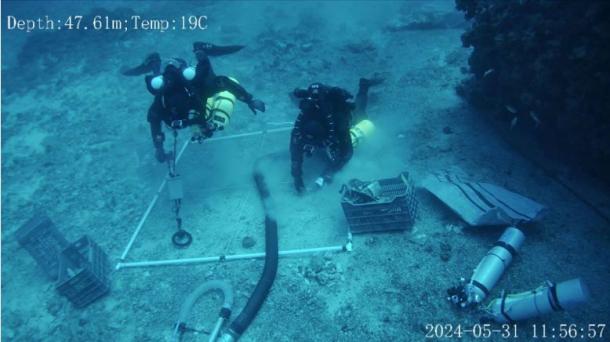🔴 Website 👉 https://u-s-news.com/
Telegram 👉 https://t.me/usnewscom_channel
The 2024 expedition to the Antikythera shipwreck marked a significant milestone in underwater archaeology. Between May 17 and June 20, under the framework of the 2021-2025 research program led by the Swiss Archaeological School in Greece and supervised by the Ephorate of Marine Antiquities. Ideal weather conditions allowed for extensive excavation, yielding numerous artifacts, with the most notable being a substantial part of the ship’s hull. What’s more, a second area of interest has offered up evidence that the site is one of multiple wrecks.
The Greek Ministry of Culture and Sport reports, how the team have made remarkable progress, with a systematic scientific approach, the first since the wreck’s discovery by Simian spongers in 1900, aimed to enhance understanding of the site and the ancient ship’s rich cargo.
Led by Dr. Angeliki G. Simosi and Professor Lorenz Baumer, the international research team tackled questions about the wreck, including whether it involved more than one ship, the circumstances of the wreck, and the identities of the human remains found in recent years.
Second Ship Found At the Antikythera Shipwreck! Breakthroughs in 2024
Advanced Techniques and Technology
To address these questions, the team utilized various advanced techniques. A database and Geographic Information System (GIS) from previous years aided planning and feedback. Remotely operated vehicles (ROVs) from Hublot Xplorations and the Coast Guard’s Undersea Mission Unit monitored operations in real-time and created digital 3D models of selected areas. Special scanners developed by Hublot’s R&D department produced 3D models of lifted objects.
A specialized manned underwater surface survey covered two distinct collection sites 200 meters (219 yrds) apart, referred to as Areas ‘A’ and ‘B’. The goal was to locate, identify, and document remains of utilitarian pottery and transport vessels, with selected samples retrieved for further study. New closed-circuit mixed-gas diving devices enhanced the efficiency and safety of these procedures.
A new limited-intervention excavation method was also applied, focusing on selected 2×2 meter zones. Extracted sediments were studied in a field-based micro-geoarchaeological lab, allowing precise stratigraphic observations and revealing the site’s complexity and differing formation processes between Areas ‘A’ and ‘B’.
Analysis of phytoliths, resins, and caulking materials provided crucial insights into the ship and its cargo.
Exposing a large part of the ship’s hull. (Greek Ministry of Culture)
Rich Archaeological Finds
The excavations yielded about 300 objects or groups of objects, including 21 marble fragments (18 from statues), numerous structural elements of the ship’s hull, and over 200 pottery fragments.
The most significant find was a structural part of the ship’s hull, revealing previously hypothesized shipbuilding features. This section included wooden planks forming the outer shell with transverse reinforcements, connected using copper pins and coated with a protective lead layer. This discovery pinpointed the ship’s seabed location and orientation, raising the question of whether multiple ships were involved in the Antikythera event.
Second Wreck Site Revealed
Area ‘B’, investigated due to its pottery concentration similar to Area ‘A’, yielded remains of another wooden ship beneath its cargo. These findings, documented and retrieved for analysis, aim to clarify the relationship between the two areas. Modern digital recording methods enriched the 3D models of the seabed surface.
Marble thumb or toe among artifacts at the site. (Greek Ministry of Culture)
Marble and Ceramics Analysis
Recovered marble fragments suggested a concentration of sculptural works in Area ‘A’, including fragments of marble heads, fingers, extremities, and clothing parts, likely from different statues.
Ceramic findings included commercial amphorae of various types, with Coan amphorae being abundant at the wreck site. Lamboglia 2 amphorae were more numerous than expected and divided into three subcategories. Area ‘B’ revealed previously unattested types, including amphorae from Chios and a Rhodian amphora with twisted handles.
Ceramic amphoras recently recovered at the Antikythera site, of various origins, including lower Italy, Rhodes, Kos. (Greek Ministry of Culture)
A field micro-geoarchaeology lab enabled visual and microscopic analysis of ceramic bodies and residues, identifying mastic used as a coating in some amphorae.
Other pottery vessels found included a lagynus and a two-handled skyphos, along with unconfirmed forms of table pottery in Area ‘B’.
Collaboration and Future Research
The “Return to Antikythera” program, supported by S.A. President Katerina Sakellaropoulou and sponsors like Hublot, the Aikaterini Laskaridis Foundation, and the Nereus Research Foundation, showcased international cooperation. The team received substantial support from the Ministry of Culture, local authorities, and residents of Antikythera.
Future research will focus on extensive laboratory analysis of the hull samples to understand the shipbuilding techniques, types of wood used, and the ship’s provenance. The new findings open possibilities for uncovering more about the ancient maritime tragedy and the lives of those involved.
Top image: Remnants of a second ship found at the Antikythera site in Greece, and right, marble artifact. Source: Greek Ministry of Culture
By Gary Manners




